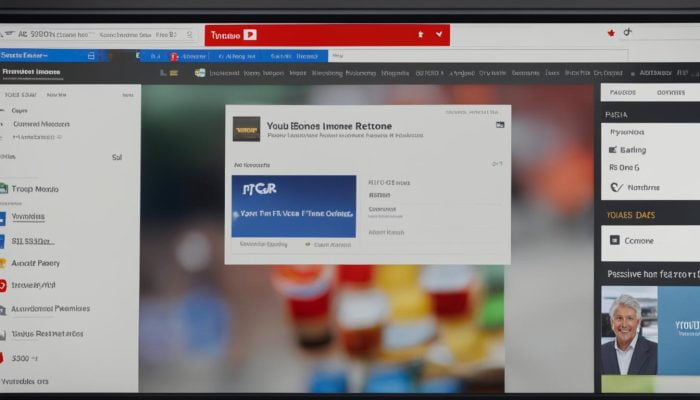Are you a retiree looking to boost your income without making any upfront investments? Generating passive income is an excellent way to create extra cash flow to support your retirement lifestyle. Fortunately, there are numerous passive income ideas that you can consider, even with no investment required. In this article, I will explore some of the best passive income ideas specifically tailored for retirees like you.

Key Takeaways:
- Passive income is a valuable strategy for retirees to boost their retirement income
- Renting out your home and participating in peer-to-peer renting are great ways to generate passive income
- Investing in real estate, creating and selling digital products, and affiliate marketing are other viable options for retirees
- Retirees can also consider generating passive income through investments and creating a YouTube channel
- It’s important for retirees to carefully evaluate each passive income opportunity and choose the ones that align with their skills, interests, and financial goals
Renting Out Your Home for Passive Income
One of the most popular ways for retirees to generate passive income is by renting out their homes. By utilizing home sharing platforms like Airbnb, retirees can list their properties and earn extra income by renting out spare rooms or even the entire property. This allows retirees to take advantage of their existing asset and turn it into a source of income.
Home sharing platforms like Airbnb provide retirees with a convenient way to connect with potential renters and manage bookings. Retirees can set their own rental rates, decide on the availability of their property, and screen potential guests. This level of control allows retirees to rent out their homes on their own terms and provides flexibility to accommodate their retirement lifestyle.
Renting out a home for passive income not only provides retirees with an additional stream of cash flow but also offers other benefits. It allows retirees to meet new people from different parts of the world, potentially expanding their social network. Additionally, renting out a home can also provide retirees with a sense of purpose and fulfillment as they share their space and create memorable experiences for guests.
“Renting out my home through Airbnb has been a great source of passive income during my retirement. It’s allowed me to earn extra money while meeting interesting people from all over the world. Plus, it’s given me a sense of purpose and keeps me active in managing my property.” – Jane, retired homeowner
Table: Pros and Cons of Renting Out Your Home for Passive Income
| Pros | Cons |
|---|---|
| Additional source of income | Requires time and effort to manage bookings and guests |
| Flexibility to set rental rates and availability | Potential wear and tear on the property |
| Opportunity to meet new people and expand social network | May need to comply with local regulations and obtain necessary permits |
| Potential tax deductions for expenses related to renting out the property | Periods of low or no occupancy |
Overall, renting out your home for passive income can be a lucrative venture for retirees. However, it is important to carefully weigh the pros and cons and take into account factors such as local regulations, property maintenance, and personal preferences before deciding to rent out your home. By doing so, retirees can make an informed decision that aligns with their financial goals and retirement lifestyle.

Peer-to-peer Renting for Extra Income
The sharing economy has revolutionized the way we utilize our assets and create additional sources of income. Retirees can take advantage of this trend by participating in peer-to-peer renting, a practice that allows them to rent out their belongings to others in exchange for passive income.
Platforms like Outdoorsy, Turo, and ShareGrid provide retirees with the opportunity to list their items, such as RVs, sports equipment, or camera gear, and connect with potential renters. By renting out these underused assets, retirees can generate a steady stream of passive income while helping others enjoy the use of their belongings.
This form of peer-to-peer renting not only allows retirees to monetize their assets but also contributes to the sustainability of the sharing economy. By sharing resources instead of purchasing new ones, retirees can reduce waste and promote a more environmentally friendly lifestyle.

Benefits of Peer-to-peer Renting:
- Generates passive income by renting out underused assets
- Contributes to the sustainability of the sharing economy
- Allows retirees to help others enjoy their belongings
- Provides an opportunity to connect with like-minded individuals
Peer-to-peer renting is a win-win situation for retirees. They can earn passive income while helping others make the most of their belongings. It’s a great way to tap into the sharing economy and create a sustainable source of additional income.
| Item | Platform | Potential Earnings |
|---|---|---|
| RV | Outdoorsy | $500 – $1,000 per week |
| Sports Equipment | Turo | $50 – $100 per day |
| Camera Gear | ShareGrid | $25 – $50 per day |
By participating in peer-to-peer renting, retirees can unlock the earning potential of their belongings and create a reliable source of passive income. It’s a flexible and rewarding way to leverage their assets while contributing to a more sustainable and connected community.
Investing in Real Estate for Passive Income
Real estate investing is a tried and tested method for generating passive income. By purchasing rental properties or investing in Real Estate Investment Trusts (REITs), retirees can secure regular income without the need for active management. While owning rental properties may require some initial work, it can provide a steady stream of passive income once the properties are established.
Investing in rental properties allows retirees to earn rental income from tenants. They can choose to buy residential properties, such as apartments or single-family homes, or invest in commercial properties like office buildings or retail spaces. By carefully selecting properties in high-demand locations and ensuring they are well-maintained, retirees can attract reliable tenants and generate a consistent rental income.
An alternative option is to invest in Real Estate Investment Trusts (REITs). REITs are companies that own and manage income-generating real estate properties. By investing in REITs, retirees can benefit from the rental income or dividends generated by these properties without the need to directly own or manage them. REITs often specialize in specific sectors, such as residential, commercial, or industrial properties, allowing retirees to diversify their real estate investments.
When considering real estate investing for passive income, retirees should carefully evaluate the potential risks and rewards. They should research the local real estate market, analyze property values and rental rates, and consider factors such as property taxes and maintenance costs. Additionally, retirees may choose to work with real estate agents or financial advisors who specialize in real estate investments to ensure they make informed decisions.
Table: Pros and Cons of Real Estate Investing for Passive Income
| Pros | Cons |
|---|---|
| Steady rental income | Requires initial capital investment |
| Potential for property value appreciation | Property management responsibilities |
| Tax advantages, such as deductions | Market fluctuations can affect property value |
| Potential for passive income growth over time | Risks associated with vacancy or non-paying tenants |
Overall, investing in real estate can be a viable strategy for retirees to generate passive income. Whether through rental properties or REITs, real estate investments have the potential to provide a consistent and reliable source of income, supplementing retirees’ retirement savings. However, retirees should approach real estate investing with careful consideration, conducting thorough research and seeking professional advice to maximize their chances of success.
In real estate, the golden rule is location, location, location. Investing in properties located in high-demand areas can increase the chances of attracting quality tenants and achieving higher rental income. It’s essential to carefully analyze market trends and property values before making any investment decisions.
Creating and Selling Digital Products
Retirees with specialized knowledge or skills can tap into the digital market by creating and selling their own digital products. This allows them to leverage their expertise and generate passive income from anywhere in the world. Two popular options for digital products are e-books and online courses.

Creating E-books
E-books are a great way for retirees to share their knowledge and experiences in written form. Whether it’s a memoir, a how-to guide, or a niche-specific book, retirees can self-publish their e-books on platforms like Amazon Kindle Direct Publishing. With the right marketing and promotion, e-books can provide a passive income stream as they can be sold to multiple customers without additional effort.
Developing Online Courses
Retirees with expertise in a particular field can create and sell online courses. Online learning platforms like Udemy and Teachable provide a user-friendly interface for creating and hosting courses. Retirees can package their knowledge into video lessons, quizzes, and assignments, and earn passive income by selling access to their courses. Online courses have the added benefit of scalability – once created, they can be sold to thousands of students without any additional effort on the retiree’s part.
“Retirees can leverage their specialized knowledge and skills to create and sell e-books or online courses.”
By creating and selling digital products like e-books or online courses, retirees can unlock new streams of passive income. These products allow retirees to share their expertise and experiences while earning income from their intellectual property. Whether it’s through self-publishing e-books or developing online courses, retirees can tap into the digital market and enjoy the benefits of passive income.
Affiliate Marketing for Passive Income
Affiliate marketing is a powerful strategy for generating passive income through website monetization. By partnering with affiliate networks like Amazon Associates or Awin, retirees can earn a commission for promoting other people’s products or services. With a strong website or social media presence, retirees can attract an audience and recommend relevant products or services, earning passive income through their referral links.

“Affiliate marketing allows retirees to leverage their expertise and passions to generate passive income. By recommending products or services they believe in, retirees can earn a commission for each sale made through their referral links.”
One of the key advantages of affiliate marketing is its passive nature. Once the affiliate links are set up on your website or social media platforms, the income can continue to flow in, requiring minimal ongoing effort. This makes it an ideal strategy for retirees looking to supplement their retirement income without taking on additional work or responsibilities.
Benefits of Affiliate Marketing for Retirees:
- Flexibility: Retirees can choose the products or services that align with their interests and expertise, promoting only what they genuinely believe in.
- No inventory or customer service: As an affiliate marketer, retirees don’t need to worry about product inventory, shipping, or handling customer inquiries. They simply earn a commission for each sale made through their referral links.
- Low start-up costs: Affiliate marketing requires minimal upfront investment, making it accessible for retirees with limited financial resources.
- Scalability: There is no limit to how many affiliate partnerships retirees can establish, allowing them to scale their passive income as they grow their online presence.
Overall, affiliate marketing presents a lucrative opportunity for retirees to generate passive income by leveraging their website or social media platforms. By recommending products or services they believe in, retirees can earn a commission for each sale made through their referral links. With its flexibility, low start-up costs, and potential for scalability, affiliate marketing is a compelling strategy for retirees seeking to boost their retirement income.
Generating Passive Income through Investments
Investing in various avenues can be a smart and effective way for retirees to generate passive income and grow their retirement savings. By strategically allocating their funds, retirees can benefit from regular income streams without the need for active management. Here are some popular investment options that can help retirees generate passive income:
Diversify with Dividend Stocks
Dividend stocks are shares of companies that distribute a portion of their profits to shareholders on a regular basis. Retirees can invest in dividend stocks and receive a consistent stream of passive income through dividend payments. It is important to diversify investments across different sectors and industries to mitigate risks and ensure a stable income flow. Researching and selecting dividend stocks with a history of consistent and growing dividends can provide retirees with reliable income in the form of dividends.
Maximize Returns with Index Funds
Index funds are investment funds that track a specific index, such as the S&P 500. By investing in index funds, retirees can gain exposure to a diversified portfolio of stocks without the need for active management. These funds aim to match the performance of the underlying index, allowing retirees to benefit from the overall growth of the market. Index funds are known for their low fees and passive investment strategy, making them an ideal option for retirees seeking steady and hassle-free passive income.
Steady Income with Bonds
Bonds are fixed-income securities that pay regular interest to the bondholder. Retirees can invest in government or corporate bonds and earn passive income in the form of interest payments. Bonds are considered relatively low-risk investments compared to stocks, making them attractive for retirees seeking stability and predictable income. It is important to consider factors such as bond rating, maturity date, and interest rate when selecting bonds to ensure a favorable risk-reward balance.
| Investment Option | Potential Returns | Risk Level |
|---|---|---|
| Dividend Stocks | Potential for high returns through dividend payments | Moderate to high |
| Index Funds | Steady returns based on the performance of the underlying index | Low to moderate |
| Bonds | Predictable income through regular interest payments | Low to moderate |
It is important for retirees to carefully assess their risk tolerance, investment goals, and time horizon before investing in any asset. Diversifying the investment portfolio across different asset classes can help retirees manage risks and maximize returns. Seeking guidance from a financial advisor or doing thorough research can provide retirees with valuable insights and help them make informed investment decisions.
By incorporating passive income investments such as dividend stocks, index funds, and bonds into their retirement strategy, retirees can enjoy a steady stream of income without actively managing their investments. These investment options offer retirees the flexibility and potential for growth to supplement their retirement income and achieve financial peace of mind.
Creating a YouTube Channel for Passive Income
One of the most popular and profitable ways for retirees to generate passive income is by creating a YouTube channel and monetizing it through video ads. With the rise of digital content consumption, YouTube has become a powerful platform for content creators to reach a global audience and earn money from ad revenue. By sharing their knowledge, skills, or hobbies, retirees can engage with viewers and generate a steady stream of passive income.
To start creating a YouTube channel, retirees can focus on a niche that aligns with their expertise or interests. This could be anything from cooking, DIY projects, travel, personal finance, or even storytelling. By selecting a niche, retirees can attract a specific audience who are interested in that particular topic, increasing the chances of channel growth and engagement.
Once the YouTube channel is set up, retirees can start creating high-quality and engaging video content. This can include tutorials, vlogs, product reviews, or any other type of content that resonates with their target audience. It’s important to focus on providing value and creating compelling content that keeps viewers coming back for more.
As the YouTube channel gains subscribers and views, retirees can apply for the YouTube Partner Program to monetize their videos through ads. This allows retirees to earn money from ad revenue based on the number of views and engagement on their videos. The key to success in generating passive income through a YouTube channel is consistency, quality content, and building a loyal subscriber base.

Why YouTube Channel is a Profitable Passive Income Idea for Retirees
Creating a YouTube channel for passive income offers several advantages for retirees. Firstly, it allows retirees to share their expertise, experiences, and passions with a wide audience. It’s an opportunity to connect with people who have similar interests and make a positive impact through valuable content.
Secondly, YouTube provides the potential for long-term passive income. Once videos are published, they can continue to earn ad revenue and attract new viewers over time. Retirees can enjoy the benefits of passive income while having the flexibility to work on their own terms and schedule.
Lastly, YouTube offers various opportunities for diversifying income streams. Besides ads, retirees can explore sponsorships, brand partnerships, merchandise sales, and even crowdfunding support. These additional income sources can further enhance the overall passive income generated from a YouTube channel.
Summary
Creating a YouTube channel and monetizing it through ads is a profitable way for retirees to generate passive income. By sharing their expertise and engaging with a target audience, retirees can earn ad revenue based on the views and engagement on their videos. It’s important to focus on providing valuable content, building a loyal subscriber base, and exploring additional income opportunities within the YouTube ecosystem. With dedication and consistency, retirees can enjoy the benefits of passive income while pursuing their passion for content creation.
Rental Income from Real Estate Investments
Investing in real estate can be a lucrative way for retirees to generate passive income through rental properties. By owning and renting out properties, retirees can earn a steady stream of rental income that supplements their retirement funds. Property management companies can handle the day-to-day operations, allowing retirees to enjoy a passive income source without the stress of managing tenants and property maintenance.
| Benefits of Rental Income | Considerations for Retirees |
|---|---|
|
|
Investing in rental properties requires careful consideration and planning. It’s important for retirees to assess their financial goals, risk tolerance, and the potential rental market before making any investment decisions. Consulting with a financial advisor or real estate professional can provide valuable insights and guidance.
Case Study: Retiree’s Success Story
Meet Jane, a retired teacher who decided to invest in rental properties for passive income during her retirement years. Jane carefully researched the local market and purchased two residential properties in a popular vacation destination. By listing her properties on rental platforms, she attracted tenants and generated steady rental income.
With the help of a property management company, Jane didn’t have to worry about day-to-day operations, maintenance, or dealing with tenants. The rental income from her properties provided a consistent cash flow, allowing her to enjoy her retirement without financial stress. Over time, the properties appreciated in value, further increasing Jane’s net worth and providing her with a secure future.

Investing in rental properties can be a rewarding and profitable way for retirees to generate passive income. However, it’s crucial for retirees to conduct thorough research, seek professional advice, and carefully manage their investments to ensure long-term success. With the right strategy and support, rental income from real estate investments can contribute significantly to retirees’ financial security and retirement lifestyle.
FAQ
What is passive income?
Passive income is money earned regularly with little to no effort on the part of the recipient. It is generated from various sources such as rental property, investments, or creating and selling digital products.
Why is passive income important for retirees?
Passive income provides retirees with an opportunity to boost their retirement income without making any upfront investments. It helps supplement their regular retirement income and allows them to maintain a comfortable lifestyle.
Can retirees generate passive income without any investment?
Yes, there are several passive income ideas for retirees that require no upfront investment. Renting out their home, participating in peer-to-peer renting, or creating and selling digital products are a few examples.
How can retirees rent out their home for passive income?
Retirees can list their homes on platforms like Airbnb and rent out spare rooms or the entire property. This allows them to benefit from an existing asset and generate extra income while enjoying retirement.
What is peer-to-peer renting?
Peer-to-peer renting refers to renting out belongings to others through platforms like Outdoorsy, Turo, or ShareGrid. Retirees can monetize their underused assets, such as RVs, sports equipment, or camera gear, and create a steady stream of passive income.
How can retirees invest in real estate for passive income?
Retirees can purchase rental properties or invest in Real Estate Investment Trusts (REITs) to earn rental income or dividends. While some initial work is required, owning rental properties can provide a steady stream of passive income once the properties are established.
What are digital products?
Digital products are products that can be created once and sold to multiple customers. Examples include e-books or online courses. Retirees with specialized knowledge or skills can create and sell these products, generating a passive income stream.
How does affiliate marketing work for passive income?
Retirees can promote other people’s products or services through their website or social media presence. They earn a commission for each sale made through their referral links. Partnering with affiliate networks like Amazon Associates or Awin helps retirees earn passive income through referrals.
What are some investments that generate passive income?
Retirees can invest in dividend-paying stocks, index funds, or bonds to generate passive income. These investments provide regular income in the form of dividends or interest without requiring active management.
How can retirees generate passive income through YouTube?
Retirees can create a YouTube channel, build a loyal subscriber base, and earn money from ad revenue. By sharing their knowledge or hobbies with a wide audience, retirees can generate passive income through their YouTube channel.
How can retirees generate rental income from real estate investments?
Retirees can invest in rental properties and earn rental income. While managing the properties may require some initial work, retirees can hire property management companies to handle the day-to-day operations and enjoy a steady stream of rental income.
Conclusion
Passive income ideas offer retirees a valuable opportunity to generate additional income and boost their retirement funds without the need for upfront investments. By exploring various passive income streams, retirees can secure a more financially secure and fulfilling retirement.
Throughout this article, we have discussed several passive income ideas that retirees can consider. Renting out their homes on platforms like Airbnb allows retirees to leverage their existing asset and earn extra income while enjoying their retirement. Peer-to-peer renting platforms provide retirees with the chance to monetize their underused belongings and create a steady stream of passive income.
Real estate investing, creating and selling digital products, participating in affiliate marketing, and generating passive income through investments are all viable options for retirees to explore. These opportunities provide retirees with the chance to generate income from their skills, knowledge, or existing assets, allowing them to enjoy a more financially secure retirement.
It is crucial for retirees to carefully evaluate each passive income opportunity and choose the ones that align with their skills, interests, and financial goals. By doing so, retirees can successfully generate passive income, boost their retirement funds, and create a more stable financial future.